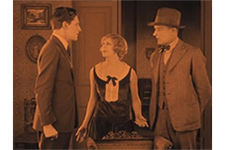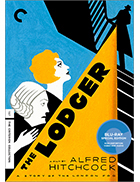The Lodger
|  The Lodger was Alfred Hitchcock’s third feature following The Pleasure Garden (1925) and The Mountain Eagle (1926), but it was, in his own words to director François Truffaut, “the first true ‘Hitchcock movie.’” Subtitled “A Story of the London Fog,” it opens with a quintessential Hitchcockian image—a close-up of a woman screaming—the first suggestion that the soon-to-be iconic director was fully embracing his sadistic side via a whodunit thriller about murder. Hitchcock has described The Lodger as the first film in which he truly exercised his style, which at the time was heavily influenced by the time he spent working in Germany in the mid-’20s, where he observed F.W. Murnau at work on The Last Laugh (1924) and saw films by Fritz Lang. The camerawork by Italian cinematographer Gaetano di Ventimiglia, who had shot Hitchcock’s previous two films, is suffused with elements of German Expressionism, from the chiaroscuro lighting, to the canted angles, to the heavy emphasis on architecture (particularly a central staircase, a feature that would show up repeatedly in Hitchcock films like Vertigo and Psycho). The London-set story is based on the most famous of Marie Belloc Lowndes’s many novels; it had already been adapted as a stageplay titled Who Is He?, which Hitchcock had seen and whose simplicity and directness he admired. It revolves around a serial killer known as “The Avenger” who preys on blonde women (the screaming woman in the opening shot being the latest victim). The central character is a young blonde model named Daisy (June); she lives with her parents (Marie Ault and Arthur Chesney), who run a boarding house, and she is romantically involved with an amiable Scotland Yard detective named Joe (Malcolm Keen), who is promoted to lead investigator on the Avenger case. One night, a mysterious stranger played by Ivor Novello, a major British star at the time, shows up at the boarding house requesting a room. Made ominous by his wide-brimmed hat and scarf, which covers his mouth and chin and accentuates his intense eyes, the man (who is known only as “the lodger”) pays for a month’s rent in advance and stays holed up in his room except when he goes out late at night on unknown errands. Daisy is intrigued by him, and they soon strike up a relationship, much to Joe’s chagrin. Soon, suspicions that the lodger is “The Avenger” begin to grow in the landlady’s mind, which is then fed by Joe’s jealous desire to pin the murders on his romantic rival. Is the lodger the serial killer the police have been tracking, or is he an innocent man wrongly accused? Both characters are, of course, staples of the Hitchcock oeuvre, and The Lodger presages Suspicion in its insidious suggestion that a matinee idol might be a sadistic murderer (the latter film starred Cary Grant). Hitchcock’s use of Igor Novello is particularly brilliant here, as he is both conventionally handsome and slightly odd; at all times we suspect he could be a murderer or simply an everyday man in the wrong place at the wrong time. Other elements familiar to Hitchcock’s work are sprinkled all throughout the film, including well-timed bits of humor to help ease some of the tension (Arthur Chesney’s bumbling husband is particularly funny at times), a healthy appreciation of sexual tension, and an almost clockwork understanding of the mechanics of suspense. As did in his earlier films, Hitchcock throws in bits of documentary-like verisimilitude to give the film a grounding in reality, although much of it is shot and framed in a kind of expressionist dreamworld. The entire film seems to be shrouded in mist (literally and figuratively), with the boarding house serving as either a respite from the damp chill outside or the lair of a serial predator. The story also gives Hitchcock plenty of room to observe and critique humanity’s more brutal tendencies, which are on full display near the climax when an enraged mob chases after the lodger. But, human decency is present, as well, primarily in Daisy, who is about as innocent a character as Hitchcock has ever put on screen. However, that decency is always set in counterpoint to the relentless threats of violence that Hitchcock introduces in the film’s opening shot and would spent the next five decades exploring in one of the finest bodies of cinematic work ever produced.
Copyright © 2017 James Kendrick Thoughts? E-mail James Kendrick All images copyright © The Criterion Collection | |||||||||||||||||||||||||||||||
Overall Rating: 


 (3.5)
(3.5)


